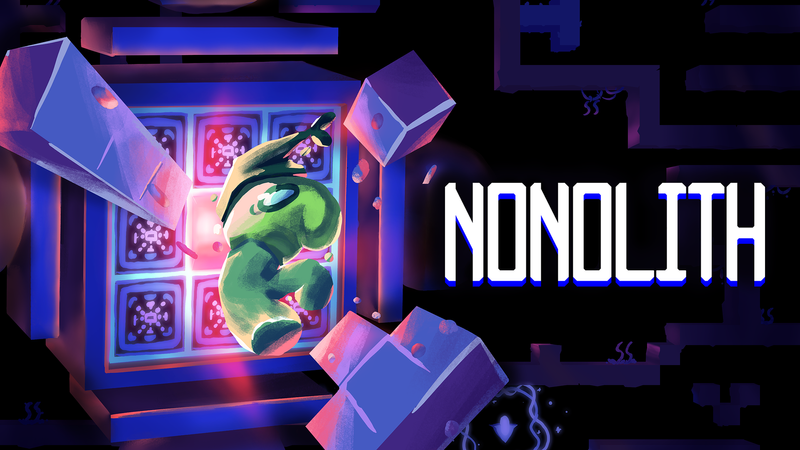I’ve played puzzle games that appear smarter than they are, and puzzle games that deceive with their apparent simplicity. Exographer is the first example I’ve encountered that is both at the same time, which is fitting given its theme. This particle physics platformer makes an absurd fuss about you acquiring a pair of sticky boots but goes on to build some surprisingly canny conundrums with those literal gumshoes. It reduces the exploration of the quantum realm into a tile-matching puzzle, but this tile-matching puzzler is nonetheless surprisingly capable of entangling your brain.
Yet what ultimately defines Exographer is not its intelligence, but its personality. However earnest or performative its ingenuity is, it is never less than a lovely game to spend time with, exploring its subject matter with a warm, empathetic tone and boundless enthusiasm.
Exographer sees you play as an alien adventurer named Ini, dispatched to assist an ancient alien civilisation in the midst of a crisis. After an excellent opening sequence where your extraterrestrial explorer steps through a portal and reassembles on the far side pixel-by-pixel, you descend into the society’s crumbling buildings and abandoned laboratories to discover what, exactly, befell it.
Although the precise nature of the civilisation’s fate is unclear, two things quickly become apparent. First, its citizens were massively into particle physics, to the point where their whole settlement is essentially one giant research facility dedicated to subatomic spelunking. Second, the facility is befouled by an array of strange substances, including glowing yellow rock formations and lethally sticky mud.
The details of the downfall, and how the science and the substances connect, are unveiled via a novel narrative framing device. Ini is equipped with a tablet containing a special analytical camera, which you are encouraged to take screenshots of the environment with. Initially, this camera looks like it will be used for puzzling purposes. Not only does any screenshot you take double as a quicksave, you can also use it to teleport Ini to specific landmarks you snap, letting you revert to these locations without losing any progress.
However, both these abilities turn out to be failsafes for if you get stuck. Instead, the primary function of the camera is to deliver the story and contextualising objectives. When you take screenshots of certain objects (usually the same ones you can teleport between) it unveils information about those objects on corresponding panels in your tablet. Taking pictures of a defunct satellite array, for example, might provide information on how to realign it, while other snaps might furnish you with clues hinting at how to restart a particle accelerator (most of Exographer’s objectives involve fixing complex scientific equipment).
Some puzzles cannot be solved by photography alone, however, and as such your tablet can perform one final task, analysis. The equipment you fix was typically built to explore the quantum realm, and once you’ve got it up and running again you can use it to do the same. This is achieved by taking a screenshot of the repaired equipment and then clicking on the picture to access the analysis function. Here you’ll be asked to match several tiles on a line diagram that represents the movement of subatomic particles.
Completing these will generally introduce you to a whole new particle (which Exographer calls ‘pixules’) such as electrons, gluons, muons, and so forth. Some of these discoveries relate only to the story. Others have more practical effects. Discovering photons unlocks a special energy shield that reacts with the glowing rock I mentioned, letting you walk straight through it as if it wasn’t there. Discovering gluons, meanwhile, rewards you with the aforementioned sticky boots, letting you walk on certain walls and ceilings.
On one level, this is a convoluted way to dress up some elementary video game abilities, which is why I say Exographer can present as smarter than it is. That said, the way it presents these ideas succeeds in making you feel like a scientist on a journey of discovery, and while I am not equipped to tell you precisely how authentic Exographer’s use of these terms is, it is designed by an actual physicist.
Yet while Exographer may gloss up some rudimentary video game systems with fancy boffin jargon, the way it uses those systems does become more involved as you progress. Let’s start with analysis first. Initially, analysis literally involves matching the lines on the tiles to those shown on screen. Soon, though, you quickly pick up an array of “analysis tools” that ironically make analysis more complicated. Some lines, for example, are secretly wavy, so you pick up a filter called a Mediagram to identify these. Some flow forward in time while others flow backward, so you pick up a Chronogram that highlights which way time flows along the line. Other tools include a zoom function which adds extra layers to the puzzles, and a Pixulometer for identifying lines created by specific pixules.
By Exographer’s halfway point, what at first appears to be a very simplistic puzzle system has become pretty complex, requiring close examination of each line to match it with the appropriate tiles That said, I do think the systems adds one curveball too many. The final tool is a scanner that requires you to scan the nodes where you place the tiles for hidden extra lines, a tedious process.
As for the in-world abilities, while individually they may seem straightforward, Exographer frequently requires you to combine them in interesting ways. For example, you might need to use your energy shield to pass through a floor made of glowing rock, then switch to your sticky boots to walk along the underside of that rock formation. The platforming becomes especially interesting when you acquire a pair of gloves that let you move some of these substances around, often in a way that requires quickfire use of other abilities to access the next area.
When you combine these abilities with the analytical puzzles and the gradual unveiling of the mystery, it adds up to an engrossing adventure. What ties it all together though, is the presentation. The world is convincingly, coherently imagined, rendered in exquisite pixel art that does a stellar job of conveying the scale and weirdness of Exographer’s alien civilisation. There are some breathtaking moments when the camera pulls back to show you a stunning panorama or colossal bit of machinery, such as when you ascend through a giant microscope built into a cavern by crossing its lenses on foot, showing you the invisible realms of quarks, atoms, and cells in the process.
The story, meanwhile, is smartly delivered through snippets and morsels, with each photograph you take unveiling another record of the society’s experiments. It’s a fragmentary narrative that keeps you at arm’s length, leaving you to infer many of its ramifications. What does shine through is the curiosity and enthusiasm of the scientists whose footsteps you trace, as well as the tragedy of their failure to avert the disaster. Crucially, the notes you find also trace the history of their discoveries, the dates at the bottom of each extract revealing a timespan of more than a hundred years. It reveals the downfall of their civilisation is not sudden and violent, but slow, sad, and yet ever-hopeful.
There are a few quibbles I could raise, such as the eccentric keyboard controls, and a few puzzles overly skewed toward reflex rather than reasoning (such as a timed puzzle involving fluid pumps). Mostly though, Exographer is an enhancing, enriching, and deeply original scientific odyssey that is well worth discovering.







